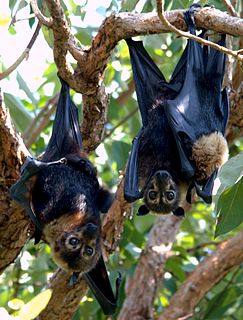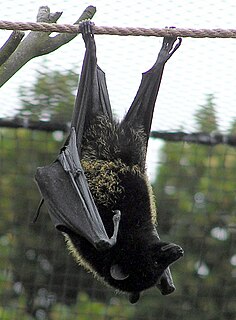
Megabats constitute the family Pteropodidae of the order Chiroptera (bats). They are also called fruit bats, Old World fruit bats, or—especially the genera Acerodon and Pteropus—flying foxes. They are the only member of the superfamily Pteropodoidea, which is one of two superfamilies in the suborder Yinpterochiroptera. Internal divisions of Pteropodidae have varied since subfamilies were first proposed in 1917. From three subfamilies in the 1917 classification, six are now recognized, along with various tribes. As of 2018, 197 species of megabat had been described.

The giant golden-crowned flying fox, also known as the golden-capped fruit bat, is a species of megabat endemic to the Philippines. Since its description in 1831, three subspecies of the giant golden-crowned flying fox have been recognized, one of which is extinct. The extinct subspecies was formerly recognized as a full species, the Panay golden-crowned flying fox. Formerly, this species was placed in the genus Pteropus; while it is no longer within the genus, it has many physical similarities to Pteropus megabats. It is one of the largest bat species in the world, weighing up to 1.4 kg (3.1 lb)—only the Indian and great flying fox can weigh more. It has the longest documented forearm length of any bat species at 21 cm (8.3 in).

The Mariana fruit bat, also known as the Mariana flying fox, and the fanihi in Chamorro, is a megabat found only in the Mariana Islands and Ulithi. Habitat loss has driven it to endangered status, and it is listed as threatened by the US Fish and Wildlife Service. Poachers and food hunters, other animals, and natural causes have led to the decline.

Pteropus is a genus of megabats which are among the largest bats in the world. They are commonly known as fruit bats or flying foxes, among other colloquial names. They live in South Asia, Southeast Asia, Australia, East Africa, and some oceanic islands in the Indian and Pacific Oceans. There are at least 60 extant species in the genus.

The spectacled flying fox, also known as the spectacled fruit bat, is a megabat that lives in Australia's north-eastern regions of Queensland. It is also found in New Guinea and on the offshore islands including Woodlark Island, Alcester Island, Kiriwina, and Halmahera.

Livingstone's fruit bat, also called the Comoro flying fox, is a megabat in the genus Pteropus. It is an Old World fruit bat found only in the Anjouan and Mohéli islands in the Union of the Comoros in the western Indian Ocean.

The Aldabra flying fox is a species of megabat in the genus Pteropus. It is endemic to the Aldabra Atoll in the Seychelles, like Chaerephon pusilla, though the latter may be the same species as the little free-tailed bat.

The Ryukyu flying fox or Ryukyu fruit bat is a species of megabat in the family Pteropodidae. It is found in Japan, Taiwan, and the Batanes and Babuyan Islands of the Philippines. Its natural habitats are subtropical or tropical dry forests and subtropical or tropical swamps. It is threatened by habitat loss and by hunting for food and the IUCN classify it as "Vulnerable".

The Banks flying fox is a species of megabat in the family Pteropodidae. It is endemic to Vanuatu. Its natural habitats are subtropical or tropical dry forests and subtropical or tropical swamps. These small fruit bats are about 15 cm. long with grey and brown on its head and back with a yellow-orange neck and yellow-gray bellies. Its diet consists of coconut flowers and Vaveli trees fruit since its home is tropical.

The black-eared flying fox, species Pteropus melanotus, is a bat of the family Pteropodidae (megabats). Also known as Blyth's flying fox, it is found on the Andaman Islands and Nicobar Islands (India), and in Sumatra (Indonesia). A population on Christmas Island, which is critically endangered, has been placed as a subspecies of this population. The conservation and taxonomic status of that population was later re-established as a distinct species, the Christmas Island fruit-bat Pteropus natalis.

The Temotu flying fox is a species of flying fox in the family Pteropodidae. It is endemic to the Solomon Islands. It is threatened by habitat destruction due to subsistence agricultural practices, as well as natural disasters such as tropical cyclones. Due to its imperiled status, it is identified by the Alliance for Zero Extinction as a species in danger of imminent extinction. In 2013, Bat Conservation International listed this species as one of the 35 species of its worldwide priority list of conservation.

Pteropus pelagicus is a species of fruit bat in the family Pteropodidae. It includes two subspecies that were formerly recognized as full species— Pteropus insularis and Pteropus phaeocephalus. It is endemic to Micronesia. It is threatened by habitat loss.

The Bonin flying fox, Bonin fruit bat, or in Japanese Ogasawara giant bat is a species of flying fox in the family Pteropodidae. It is endemic to four islands in Ogasawara Islands, Japan. Its natural habitat is subtropical forests. It is threatened by habitat loss.

The Rodrigues flying fox or Rodrigues fruit bat is a species of bat in the family Pteropodidae, the flying foxes or fruit bats. It is endemic to Rodrigues, an island in the Indian Ocean belonging to Mauritius. Its natural habitat is tropical lowland forests. The bats are sociable, roost in large groups during the day and feed at night, squeezing the juice and flesh out of fruits. They are hunted by humans for food and their numbers have been dwindling, and the International Union for Conservation of Nature has rated the species as being "endangered". In an effort to preserve them from extinction, some bats have been caught and are being bred in various zoos around the world.

The Vanikoro flying fox, also known locally as basapine, is a species of bat in the family Pteropodidae. It has only been found in the Vanikoro island group located in the southern Solomon Islands. The species as a whole was originally known from just a few specimens collected sometime before 1930 but following surveys conducted on the island in the early 1990s did not detect this species again causing the Vanikoro flying fox to be listed as extinct. However, the species was rediscovered by a survey conducted in late 2014 which indicated a population in the high hundreds or low thousands and reported all observations.

The Bougainville monkey-faced bat or Bougainville flying monkey is a megabat endemic to Bougainville Island of Papua New Guinea and Choiseul Island of the Solomon Islands in Melanesia. It inhabits mature forests in upland areas, within the Autonomous Region of Bougainville and Bougouriba Province.

The New Georgian monkey-faced bat or New Georgian flying monkey is a recently described species of megabat endemic to the Solomon Islands, more specifically New Georgia and Vangunu Islands. It is presumably extinct on Kolombangara Island, and remaining population on other islands are threatened by habitat loss and hunting. Consequently, it is considered vulnerable by IUCN. In 2013, Bat Conservation International listed this species as one of the 35 species of its worldwide priority list of conservation.
Bat Conservation International (BCI) is an international nongovernmental organization working to conserve bats and their habitats through conservation, education, and research efforts.


















